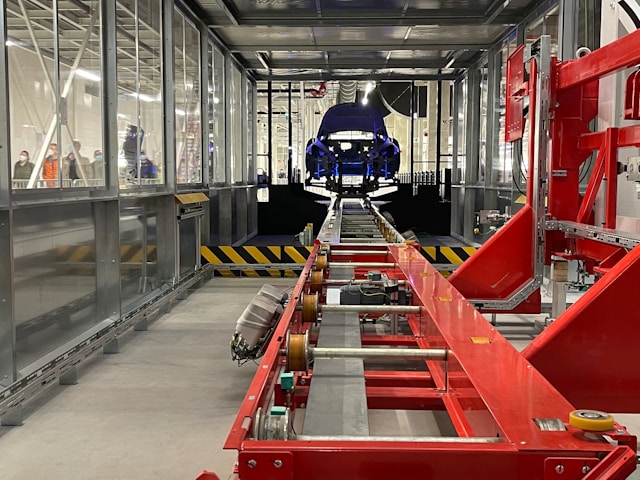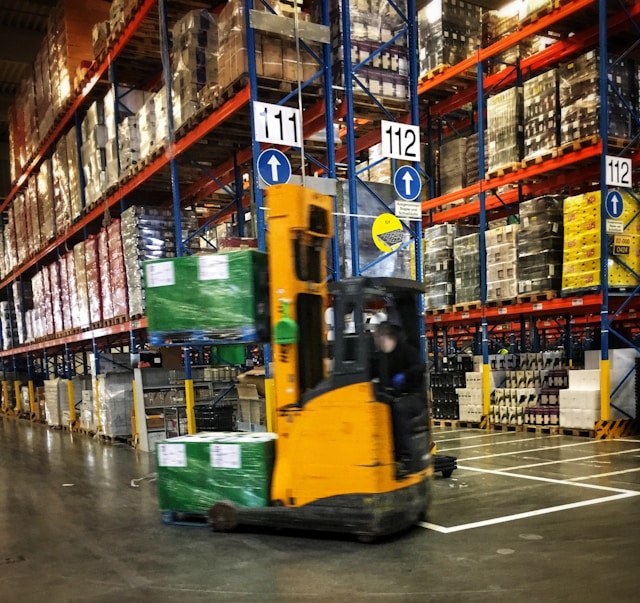In supply chain management, the idea of having zero inventory has always been a dream. While it sounds great in theory because it can save money and make operations smoother, it’s tough to achieve in real life. But businesses can still work towards this goal by planning carefully and using different strategies.
Before we go further into this topic, don’t forget to follow my LinkedIn account. You’ll get more helpful insights on supply chain management there.
Table of Contents
Understanding Zero Inventory
Zero inventory is like the gold standard of efficiency in supply chain management. It means holding just the right amount of stuff to meet what customers want, nothing more.
This idea is all about being super efficient and not wasting money or space by hoarding extra stuff.
Instead of piling up inventory as a safety net, companies using zero inventory focus on being smart and responsive to what customers need right when they need it.
Basically, zero inventory is a big change in how companies handle their stuff. Instead of waiting for things to run out or buying a bunch just in case, they’re always ready to move quickly and keep things running smoothly.
This makes everything more efficient, saves money, and helps companies stay flexible in today’s fast-changing business world.
Challenges in Achieving Zero Inventory
There are a bunch of things that make reaching zero inventory tricky.
Demand Variability
Fluctuations in what customers want can cause big headaches for businesses trying to figure out how much stuff to keep in stock. These ups and downs can happen because of different reasons, like when seasons change, people’s tastes shift, or the market surprises everyone. It’s like trying to predict the weather – sometimes it’s spot on, but other times, it’s way off.
When demand jumps around, companies risk running out of things customers want, which can mean lost sales and unhappy customers. So, keeping a close eye on inventory levels is super important to make sure there’s always enough stuff on hand to meet changing demands.

To tackle the challenge of unpredictable customer demand, businesses need to get smart about managing their inventory. This means using fancy technology and clever strategies to better understand what customers might want and when they might want it.
By digging into data and using tools like predictive modeling, companies can get a better handle on what’s coming down the pipeline.
Plus, having backup stock on standby and keeping things flexible in the supply chain can help cushion the blow when demand suddenly spikes. With these proactive approaches, businesses can stay ahead of the curve and keep customers happy, even when things get unpredictable.
Lead Time and Order Fulfillment
Even though technology has made supply chain management way better, there’s still a delay between when an order is made and when it’s delivered. This delay happens because of lots of things like how long it takes to make stuff, get materials, and ship things out.
Even with fancy systems, it’s tough to make this delay go away completely. So, businesses can’t really have zero inventory because they have to deal with this delay while also making sure they have enough stuff for customers.
To run with zero inventory, companies need to be super organized across the whole supply chain. This means working closely with suppliers, shipping companies, and everyone else involved to make things run smoothly.
Plus, using cool technology like tracking systems and smart analytics can help spot problems and fix them fast. By staying on top of things and being smart about how they manage inventory, companies can still meet customer needs even with this delay.
Production Delays and Imperfections
Manufacturing can hit roadblocks, causing problems like shortages and delays that mess up the whole supply chain. Stuff like equipment breaking down, not having enough materials, or changes in the production plan can slow things down.
Plus, if finished products have defects or quality issues, it can make things even worse by causing delays and messing up the schedule.

These hiccups don’t just affect how much stuff is available—they can cause problems all down the line, leading to shortages and messing up the whole supply chain.
When manufacturing hits snags, it’s bad news for businesses. Not having enough stuff to meet customer demand can mean losing out on sales and making customers unhappy. Plus, it can cost a lot to fix things, like rushing orders or paying for extra production time.
To avoid running short on inventory because of manufacturing problems, companies need to focus on making things run smoother, keeping quality in check, and being ready to adapt when things go wrong.
You might also like:
- How Can We Ensure that Suppliers Do Not Deliver the Required Materials Late to the Manufacturing Plant?
- Why You Need to Adjust Inventory Policies to Address Rising Sales Demands
Transportation Costs and Inventory Management
Keeping inventory in the right places in the supply chain can be super helpful for businesses. When companies strategically put inventory closer to where customers are or along shipping routes, it can save a ton of money on transportation and make products available faster.
This means less time and money spent on shipping stuff around, which is great for the bottom line. Plus, having inventory in the right spots means companies can respond quicker to customer orders and avoid running out of stock.
Not only does having inventory in the right places save money, but it also makes customers happy. When products are close by and ready to go, it means faster delivery times and less waiting for customers. This leads to happier customers who are more likely to keep coming back.
Plus, having enough inventory in key locations means companies can handle changes in demand and market trends without running into problems like running out of stock. Overall, having inventory in the right spots is a win-win for businesses and their customers.
Strategies for Approaching Zero Inventory
While achieving zero inventory may not be entirely feasible for many businesses, they can take steps to approach this ideal.
Enhanced Demand Forecasting
Using fancy data tools and smart algorithms is a big deal for businesses. By looking at all the info they collect from sales, customers, and what’s happening in the market, companies can learn a lot about what customers want. These tools can spot patterns and trends in the data that help companies make better decisions.
Plus, by using things like machine learning and predictive modeling, businesses can guess what customers will want in the future more accurately.

These tools don’t just help companies guess better—they also let them be more proactive. By knowing what’s likely to happen in the future, businesses can plan ahead and make sure they have the right amount of stuff on hand.
This means less risk of running out of stock or having too much sitting around. And when companies can meet customer needs better, it makes customers happier too.
Overall, using data tools helps businesses keep up with what’s going on in the market, plan better, and grow in today’s competitive world.
Collaboration with Suppliers
Talking openly with suppliers is super important for businesses. When companies have good relationships with their suppliers and share info with them, it helps them know what’s going on with inventory and how things are going in the supply chain. This means they can plan better and adjust orders based on what suppliers tell them, which helps keep inventory levels in check.
Plus, having real-time info from suppliers means companies can make changes quickly, avoiding problems like running out of stock or having too much stuff lying around.
On top of that, keeping the lines of communication open with suppliers helps things run smoother overall. By working together and sharing info about what’s needed and when, companies and suppliers can coordinate better and get things done faster. This means shorter wait times for customers and being able to respond faster to changes in the market.
Overall, talking openly with suppliers builds trust, strengthens partnerships, and makes everyone’s job easier in the supply chain.
Implementation of Just-in-Time (JIT) Practices
Embracing Just-in-Time (JIT) means making stuff only when customers ask for it, instead of making a bunch and storing it. This helps companies save money by not having too much stuff sitting around, which can get old or take up space.

Instead of guessing what customers will want and making a bunch based on that, JIT waits for real orders to come in before starting production. This way, companies can make exactly what’s needed, right when it’s needed.
JIT is also about making things run smoother and faster. By cutting out waste and making production more efficient, companies can get stuff done quicker and with less hassle. This means faster response times to customer orders and saving money on production costs.
Overall, embracing JIT helps companies use their resources better, operate more efficiently, and stay ahead of the competition.
You might also like:
- How to Balance Space and Inventory Levels to Maximize Warehouse Efficiency
- 6 Tips to Manage Inventory with Expiry Dates and Minimize Losses
Optimization of Manufacturing Processes
Making production more efficient is key to cutting down on time and waste in manufacturing, which means companies don’t need to keep as much extra stuff on hand.
By tweaking how things are made, businesses can speed up the process, reduce downtime, and get products out faster.
This means they can respond quickly when customers order without needing a ton of extra inventory sitting around.
Getting rid of waste in production is also super important for cutting down on extra inventory. Lean manufacturing is all about finding and fixing things that waste time or resources, like making too much, moving stuff around unnecessarily, or having mistakes in the products.
By using lean techniques and always looking for ways to improve, companies can use their resources better and make high-quality products without needing lots of extra inventory.
Overall, making production more efficient and cutting out waste helps companies stay lean and keep customers happy without needing to stockpile a bunch of extra stuff.
Active Inventory Management
Using fancy inventory systems is super important for businesses to keep track of what they have, guess what customers will want, and get stuff delivered right on time. These systems put all the info in one place, so companies can see what’s going on with inventory everywhere. They can track how much stuff they have, see where it’s going, and know if they might run out or have too much.
By looking at things like past sales, market trends, and what customers are doing, these systems help companies make smart decisions about how much stuff to have on hand.

Plus, these systems make it easier for companies to work with suppliers and shipping companies. They can see when stuff is coming in real-time, figure out the best way to get it where it needs to go, and make sure orders get out on time.
Overall, using these fancy systems helps companies run smoother, save money on inventory, and make customers happy by always having what they need.
Utilization of Technology
Using fancy tech like IoT, Big Data Analytics, and AI is a game-changer for businesses to make their supply chain better and know what inventory they need. With IoT devices everywhere, companies can track inventory in real-time and fix any problems quickly. These devices also help keep inventory in good shape by monitoring things like temperature and humidity.
Big Data Analytics is like having a super brain that looks at tons of info from different places to figure out what customers want and how much stuff to have. By using smart algorithms, businesses can predict what’s going to happen and make sure they have the right amount of inventory at the right time.
Plus, AI algorithms can adjust inventory levels automatically when things change, so companies don’t run out or have too much sitting around. Overall, using these fancy tech tools helps businesses be smarter about inventory, save money, and keep customers happy.
Resilient Supply Chain Design
Making supply chains that can bend and bounce back is key for businesses to handle problems without needing a ton of extra inventory. Being flexible means being able to change quickly when things in the market or supply chain shift unexpectedly. This might mean having backup suppliers or being able to change production plans fast.
And when things do go wrong, being resilient means being able to bounce back fast. This might involve having backup systems in place or keeping extra stock of important stuff. By making supply chains that are flexible and tough, businesses can handle problems better and keep inventory levels in check without needing a lot of extra stuff lying around.
You might also like:
- 7 Ways to Manage Material Specification Changes in the Warehouse to Ensure Smooth Transitions
- 10 Strategies to Overcome Data Processing Challenges for Supply Chain Teams Lacking Expertise
Proactive Safety Stock Management
Even if companies want to aim for having no extra stuff, they might still keep some extra just in case. Some reasons for this as below.
Supply Chain Disruptions
To make sure they don’t run into trouble, companies sometimes keep extra stuff on hand as a backup plan. This extra stock acts like a safety net, helping out if deliveries get delayed or things go wrong in the supply chain. It means that even if demand suddenly shoots up or there’s a problem with getting stuff in on time, customers won’t have to wait or miss out on what they ordered.
While having this extra stock costs money for storage and handling, it’s like having insurance against delivery problems. By managing how much extra stock they keep based on things like how much demand varies or how reliable the supply chain is, companies can balance keeping customers happy with not spending too much on inventory.

Plus, having this backup stock means customers can always get what they need, which keeps them happy and loyal to the brand, even when things don’t go as planned in the supply chain.
Seasonal Variations or Customer Behavior
Being ready for sudden jumps in demand, like during holidays or when things change unexpectedly, is super important for businesses to keep customers happy.
Companies need to plan ahead and make sure they have enough stuff on hand when demand goes up, so customers don’t miss out. This might mean making more stuff before busy times, getting extra inventory from suppliers, or being flexible in how they manage their supply chain to handle the rush.
And when things change out of the blue, businesses need to be quick to respond. By keeping an eye on what’s happening in the market and what customers like, companies can adjust their plans and inventory levels to keep up. Using fancy tools like data analytics helps them see what’s coming and make changes before it’s too late.
Overall, being ready for sudden jumps in demand and unexpected changes in customer behavior helps businesses stay flexible, keep customers happy, and stay ahead of the competition.
Market Uncertainty or External Disruptions
To stay safe from unexpected problems like economic ups and downs or changes in trade policies, businesses need to be prepared. Economic uncertainty, like when money values change or there’s a recession, can mess up supply chains by messing with what people want or how much stuff costs. To handle this, companies can spread out where they get their stuff from, buy locally, or have backup plans ready so they can keep getting what they need even if things get rocky.
And when trade policies change or there’s tension between countries, it can make things even trickier. New rules or tariffs can mess up how things are usually done, making it harder to get stuff in or making it cost more.

To deal with this, businesses can look for different places to get their stuff, see how new policies might affect them, and be ready to change their plans fast. By keeping in touch with suppliers and staying up to date on what’s going on in the world, businesses can be ready for anything and keep their supply chains running smoothly.
Quality or Availability of Raw Materials
Keeping extra rare or super important materials on hand is a smart move for businesses to deal with supply chain problems. Sometimes, these materials are hard to get or might suddenly become scarce or expensive because of things like political issues or production hiccups.
By having some extra stock of these materials, companies make sure they can keep making stuff even if something unexpected happens. It’s like having a backup plan to keep things running smoothly and make sure customers get what they need on time.
Having this extra stock also helps businesses be more flexible and quick on their feet. With a surplus of these materials, companies can change things up faster when demand shifts or when things happen in the market. This means they can jump on opportunities, handle changes in customer orders, and stay ahead of the competition.
Plus, by keeping an eye on what’s going on in the supply chain and managing how much extra stock they have, companies can make sure they’re ready for anything and keep their supply chains strong.
Conclusion
Businesses may not reach zero inventory right away, but they can get closer by using a mix of strategies.
First, they can predict what customers will want using fancy techniques and real-time data.
Then, they can follow JIT practices, making stuff only when needed to cut down on waste and keep inventory low.
Plus, by using cool tech like IoT and AI, they can make their supply chains run smoother and know exactly what inventory they need.
By balancing cutting down on inventory with being ready for surprises, businesses can be more flexible, save money, and keep customers happy in today’s fast-changing world.
I hope you find it helpful!
Please share this article with your colleagues so they can also benefit. For more insights on supply chain management, follow my LinkedIn account. You’re free to use all articles on this blog for any purpose, even for commercial use, without needing to give credit.

 by
by 

